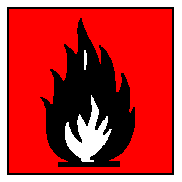International Chemical Safety Cards
| NICKEL CARBONYL | ICSC: 0064 |
| NICKEL CARBONYL Nickel tetracarbonyl C4NiO4/Ni(CO)4 Molecular mass: 170.7 CAS # 13463-39-3 RTECS # QR6300000 ICSC # 0064 UN # 1259 EC # 028-001-00-1 |
 |
 |
| TYPES OF HAZARD/ EXPOSURE |
ACUTE HAZARDS/ SYMPTOMS |
PREVENTION | FIRST AID/ FIRE FIGHTING |
| FIRE | Highly flammable. |
NO open flames, NO sparks,
and NO smoking. NO contact with oxidants. |
Powder, water spray, foam,
carbon dioxide. |
| EXPLOSION | Vapour/air mixtures are
explosive. Risk of fire and explosion upon heating above 60°C. Liquid and vapour flash
in direct sunlight. |
Closed system, ventilation,
explosion-proof electrical equipment and lighting. Do NOT use compressed air for filling,
discharging, or handling. |
In case of fire: keep
drums, etc., cool by spraying with water. Combat fire from a sheltered position. |
| EXPOSURE | |
AVOID ALL CONTACT! |
IN ALL CASES CONSULT A
DOCTOR! |
| FIRE | Abdominal pain. Blue skin.
Cough. Dizziness. Headache. Nausea. Shortness of breath. Vomiting. Symptoms may be delayed
(see Notes). |
Closed system and
ventilation. |
Fresh air, rest.
Half-upright position. Artificial respiration if indicated. Refer for medical attention. |
| SKIN | MAY BE ABSORBED! Redness.
Pain. |
Protective gloves.
Protective clothing. |
Remove contaminated
clothes. Rinse and then wash skin with water and soap. Refer for medical attention. |
| EYES | Redness. Pain. |
Face shield or eye
protection in combination with breathing protection. |
First rinse with plenty of
water for several minutes (remove contact lenses if easily possible), then take to a
doctor. |
| INGESTION | Abdominal pain. Headache.
Nausea. Vomiting (further see Inhalation). |
Do not eat, drink, or smoke
during work. |
Rinse mouth. Induce
vomiting (ONLY IN CONSCIOUS PERSONS!). Refer for medical attention. |
| SPILLAGE DISPOSAL | STORAGE | PACKAGING & LABELLING | ||
| Evacuate danger area!
Consult an expert! Collect leaking and spilled liquid in sealable containers as far as
possible. Absorb remaining liquid in sand or inert absorbent and remove to safe place.
Do NOT wash away into sewer (extra personal protection: complete protective clothing
including self-contained breathing apparatus). |
Fireproof. Separated from
strong oxidants, strong acids, food and feedstuffs. Cool. Keep in the dark. Keep under
inert gas. |
Airtight. Do not transport
with food and feedstuffs. F symbol T+ symbol R: 61-11-26-40 S: 53-45 Note: E UN Hazard Class: 6.1 UN Subsidiary Risks: 3 UN Packing Group: I Severe marine pollutant. |
||
| SEE IMPORTANT INFORMATION ON BACK | ||||
|
||||